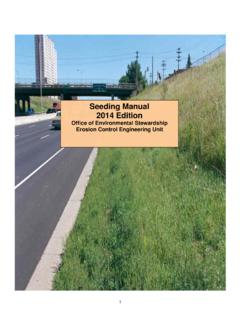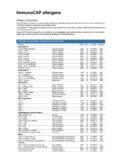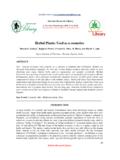Transcription of Trees: Not Recommended - Missouri Botanical …
1 Visit us on the Web: Trees: Not Recommended The following trees have serious drawbacks or can have multiple problems. Consider carefully before deciding to plant. Most are not Recommended for growing in the St. Louis area. Scientific name Common name Comments Acer negundo Box elder Box elder is a fast-growing tree with weak wood that breaks easily when stressed. They attract box elder bugs that may become pests indoors when they look for a place to overwinter. Acer rubrum Acer saccharinum Acer x freemanii Red maple Silver maple Freeman maple All three of these maples are fast growing and have problems with weak wood that breaks easily when stressed.
2 They may also cause buckling under sidewalks or driveways. Silver maple roots may invade and clog damaged sewer lines. Ailanthus altissima Tree of heaven In addition to being short-lived, weak-wooded, messy, and suckering this tree is invasive and should not be planted. Albizia julibrissin Mimosa This tree is susceptible to a serious wilt disease and the mimosa webworm. It is messy, weak-wooded and invasive in the southeast United States. Betula pendula and other northern species White birch Northern birches, including white birch, are not well-adapted to high heat and humidity and do not thrive in the St.
3 Louis area. Unhealthy trees are especially susceptible to the bronze birch borer, an insect pest that will weaken and kill the tree. Broussonetia papyrifera Paper mulberry A fast-growing but weak-wooded, suckering tree that is also very susceptible to storm damage. Elaeaganus angustifolia Elaeagnus umbellata Russian olive Autumn olive These are small trees or large shrubs that are very invasive. They are spread by birds feeding on the fruits. Fraxinus spp. Ash All North American species of ash trees are susceptible to damage by the emerald ash borer larva.
4 This insect pest has killed millions of ash trees, and until control methods have been developed, planting any kind of native ash tree is not Recommended . Gleditsia triacanthus Honeylocust Honeylocust trees have large potentially painful thorns. There are thornless trees, often listed as G. t. var. inermis (or G. t. forma inermis), but sprouts from the roots of grafted cultivars may produce thorns. These trees are susceptible to several diseases and insect pests. The fruits are large, abundant, and messy. Koelreuteria paniculata Golden rain tree Golden rain tree may attract red-shouldered bugs in large enough quantities to be annoying.
5 In some areas, this tree produces numerous seedlings and is considered invasive. Lonicera maackii Lonicera morrowi Lonicera tatarica Honeysuckle All are very invasive and should never be planted. L. tatarica is more shrub-like but L. maackii and L. morrowi can grow into small trees. Morus alba White mulberry White mulberry is invasive throughout much of the United States. Its fruits are messy and will stain. Morus rubra Red mulberry The tree is weak wooded and the fruit is messy and will stain. Its seedlings are weedy. Paulownia tomentosa Empress tree The tree is weak wooded and seedlings are weedy.
6 Pinus nigra Austrian pine Austrian pine is very susceptible to a severe tip blight disease that weakens and kills affected trees. Pinus sylvestris Scotch pine Scotch pine is not well-adapted to the St. Louis climate and does not do well in high heat and humidity. The resulting unhealthy trees are more susceptible to disease and insect pests. Populus spp. and hybrids Poplars Cottonwood Lombardy poplar Aspen Poplars are susceptible to many diseases and insect pests, especially those poplars that are native to cooler climates, and do not grow well in the heat and humidity of a St Louis summer.
7 Branches are structurally weak and break when stressed by wind or snow. Roots may buckle sidewalks and invade damaged sewer lines. Some species ( cottonwoods) produce seeds with silky white hairs that will clog air conditioners and collect on screens and in gutters. Prunus edible cultivars Edible-fruited cherries, peaches and plums Fruiting varieties of cherries, peaches and plums are valuable landscape plants but they are susceptible to many insect pests and diseases and may require extra care. They are short-lived and the fruit can be messy if not harvested.
8 Ornamental cultivars may be fruitless or have small fruit that is quickly eaten by birds reducing problems with messy fruit. Pyrus calleryana Bradford Bradford pear Bradford pears have weak limb structure that causes them to lose branches or even topple over when stressed by wind, ice or snow. Quercus palustris Pin oak Pin oaks require acidic soil to stay healthy and are subject to several diseases and insect pests including galls and oak wilt. The drooping lower branches, which die but remain on the tree are unattractive and limit access to the area under the tree.
9 Robinia psuedoacacia Black locust Black locust has an aggressive root system that will spread by suckers and may disrupt adjacent areas. It is susceptible to several diseases and insect pests. It has thorns and with its abundant fruit, it may be considered messy. Although native to much of the United States, it may become invasive in grassland areas. Salix spp. White willow Weeping willow Willows are fast-growing but weak wooded trees very susceptible to damage in storms. Weeping willows drop small branches almost constantly. Many willows are susceptible to late spring frosts and cold events that can result in many dead twigs.
10 Canker diseases can also result in dead twigs and limbs. Sorbus spp. Mountain ash Mountain ash trees are lovely in flower and fruit but do not perform well in the St. Louis area. Ulmus americana American elm American elm is subject to the fatal Dutch elm disease. There are resistant cultivars such as Valley Forge and Jefferson but they may still require regular pruning and spraying to maintain good health. Ulmus pumila Siberian elm With its abundant seed production and weak wood, Siberian elm requires regular clean-up of seedlings and fallen branches.
















